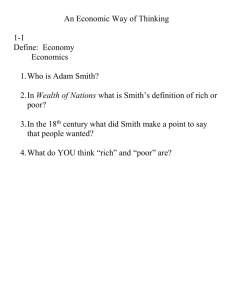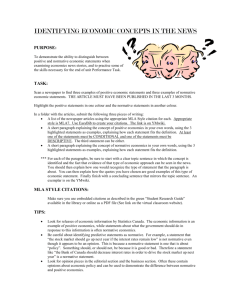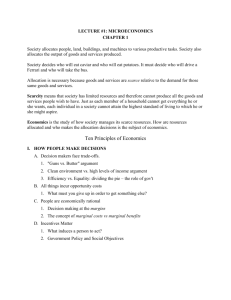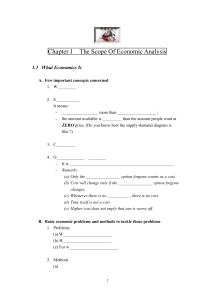The Moniac, Modeling, and Macroeconomics
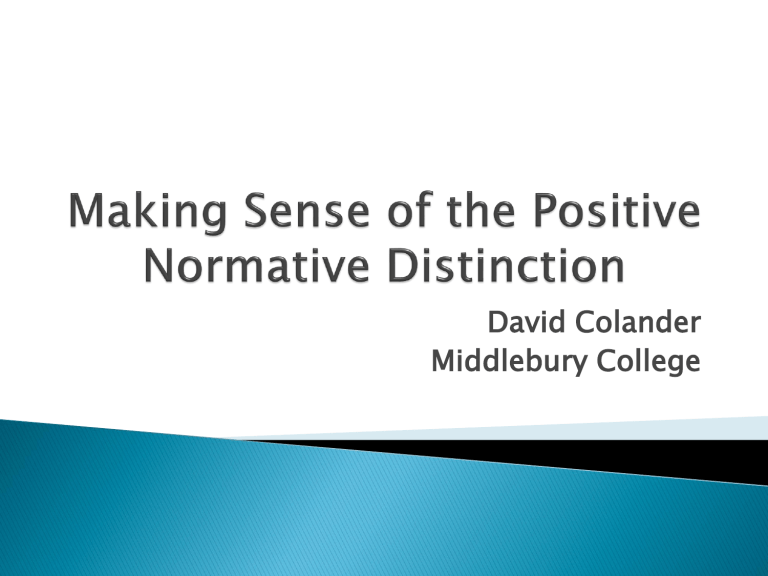
David Colander
Middlebury College
Textbooks don’t teach a whole lot of methodology.
They do teach the Positive/Normative
Distinction
Students are taught: Economists do Positive
Economics—the facts, not normative economics—the shoulds.
2
Hillary Putnam (2002) of Harvard calls it, and the related fact/value divide that he sees as accompanying it, as totally unsupportable.
John Davis (2013) calls the positive/normative distinction “indefensible.”
Their argument is essentially that values enter into everything that people do—the way they look at things, the language one uses, so to think that anything is fully objective, or positive, is unsupportable.
Economics is seen that having failed to incorporate that sensibility, and its positive/normative distinction, is seen as a relic of its logical positivist roots.
3
Positive economics is a science. It is value free. It considers “what is”. It provides facts
Normative economics is value laden—what should be?
Economists do positive economics, not normative economics
In my text I don’t present that 2-part distinction—I present a three part distinction—
Positive, Normative, and Art, where art is relating the theorems and facts determined in positive economics to the goals determined in normative economics
The goal of this presentation is to explain why I do it, and why I think all economists should do that.
4
Hubbard et al—”Positive analysis is concerned with what is, and normative analysis is concerned with what ought to be. Economics is concerned primarily with positive analysis, which measures the costs and benefits of different courses of action.”
McConnell et al—Positive economics focuses on facts and cause and effect relationships…. Normative economics looks at the desirability of certain aspects of the economy.
Positive statement: “The unemployment rate in France is higher than that in the United States.” Normative statement: “France ought to undertake policies to make its labor market more flexible to reduce unemployment rates.” Whenever words such as “ought” or “should” appear in a sentence, you are very likely encountering a normative statement
5
Normative statements are statements about what ought to be. These statements depend on values and cannot be tested... You may or disagree with these statements, but you can’t test them. They express an opinion, but they don’t assert a fact which can be checked. And they are not economics (emphasis added).
Bade and Parkin (2007)
Positive and normative statements are fundamentally different, but they are often intertwined in a person’s set of beliefs. In particular, positive views about how the world works affect normative views about what policies are desirable... Much of economics is positive: It just tries to explain how the world works. Yet those who use economics have normative goals: They want to learn how to improve the economy. When you hear economists making normative statements, you know they are speaking not as scientists, but as policy advisers.
Mankiw
Normative economics develops frameworks within which these complicated judgments [about economic policy choices] can be systematically made. Good normative economics also tries to be explicit about precisely which values or objectives it is incorporating. It tries to couch its statements in the form, “If these are your values, then this is the best policy.”
Stiglitz and Walsh (2006)
6
The government should support free trade, and oppose restrictions on trade.
The market leads to efficient outcomes.
The unemployment rate is 7%.
Rent controls are bad policy.
Increasing income taxes will decrease effort.
Cap and trade is preferable to a straight regulatory system of control.
Government should support a laissez faire policy.
Perfectly competitive markets lead to Pareto
Optimal outcomes.
7
My argument is threefold—
The first is historical: Economist’s positive normative distinction did not originate in logical positivism. It originated in a tradition that existed long before logical positivism—that goes back to Nassau Senior, John Stuart Mill,
John Neville Keynes, and Lionel Robbins.
The second is that when interpreted in its appropriate historical context, economists' use of the positive/normative distinction makes sense and is useful, and is not subject to philosopher’s criticisms. That context, however, requires a distinction between the science of economics and the art, or engineering branch, of economics. Most (98%) of what economists falls in art.
The Mill/Keynes tradition provides a better guide to methodology than philosophers or the texts. The guide is not concerned with scientific methodology; the guide is concerned with engineering methodology. It is a loose, not precise distinction. It fits with my systematic failure papers— arguing economists and economic methodologists should worry about small m methodology—rough rules of guidance—not big M methodology in science.
8
They see it as a vestige of logical positivism, that emerged in the 1920s and 1930s.
You have science, which is about truth—you put forth hypotheses, and empirically test them, rejecting all that don’t meet empirical tests.
Karl Popper and falsificationism
Lakatos—research programs
Goal: Keep normative judgments out of science.
Putnam and others have pointed out—you can’t do it. Science cannot be value free. Nothing is value free.
Post modernist attack on science.
9
It predates logical positivism. It goes back to
Mill and J. N. Keynes
Robins’ Scope and method tried to bring it back—definition of economic science—the study of the allocation of scarce resources among alternative ends
Advocated a methodology—Interpret science narrowly and keep values out of science.
At issue was interpersonal comparisons of utility.
10
Economics divided into three branches—science, art, and normative economics
Positive Science—study of what is: Output—facts and theorems
Normative—study of what should be—Output—goals of society
Art—Using the knowledge developed in the science of economics to achieve normative goals. Output—precepts. Art can be both positive and normative, depending on how it is done.
Each branch had a different methodology:
Positive Science—follow scientific methodology
Normative—largely philosophical—goals to be determined by society, or philosophers, including economics philosophers, not one’s own—these should be specified.
Art—broad and loose engineering methodology —methodology internally determined by best practices—honest broker. It is what most economists do.
Honest broker is not value free—Myrdahl’s Political Dimension of
Economics.
11
(An economist’s) conclusions, whatever be their generality and their truth, do not authorize him in adding a single syllable of advice. That privilege belongs to the writer or statesman who has considered all the causes which may promote or impede the general welfare of those whom he addresses, not to the theorist who has considered only one, though among the most important of those causes. The business of a Political Economist is neither to recommend nor to dissuade, but to state general principles, which it is fatal to neglect, but neither advisable, nor perhaps practicable, to use as the sole, or even the principle, guides in the actual conduct of affairs. (Senior 1836: 2-3)
12
The three part division was spelled out in JN Keynes’ Scope and Method, who was a close friend of Marshall.
Marshall muddied the methodological waters when he abandoned the three part division because he wanted to call his approach, which would have been called art in the Mill/Keynes tradition, science, possibly because he was pushing for a separate economics tripos at Cambridge.
To allow for the two, distinctions were made between pure science, which would be positive economics in the Mill/Keynes tradition, and realistic science, which would be considered a form of art in the Keynes/Mill tradition.
Friedman ‘s essay further muddied the waters. He cited Keynes, but then never discussed the art branch.
Friedman’s essay changed the understanding of the positive/Normative distinction. He was influenced by logical positivism and very much interested in the role of formal empirical testing, something Robbins and Keynes did not focus on, because statistics was far less developed and important in their time.
To see the distinction—ask where does welfare economics belong? Is it positive or normative? It blends both. It belongs in the art of economics.
13
It was based on logical positivism.
But he cited J. N. Keynes—three part division.
Friedman cited Keynes as the source, and then when on to forget the art.
14
Most economic methodologists agree that economics went wrong because they followed Robbins—I see them as wrong because they did not follow
Robbins and the Classical liberal methodology of Mill and JN Keynes that he followed.
The difference goes back to the interpretation of Robbins—and John is following the standard interpretation, that Robbins followed from a logical positivist position that required keeping science concerned with facts and truths, and all else next to meaningless gobbyligook.
My interpretation of Robbins is that it following the Mill/Keynes tradition that had little to do with logical positivism. My support for that is that Robbins’ claims that this is what he meant, but he could of course be wrong.
Actually my interest in this is less historical, and more immediate—I am a textbook writer and teacher and I interested in how to convey to students what economists do. I find the existing discussion of the normative/positive distinction in texts (other than mine) confusing. I want to make the distinction clearer, and I think the Mill/Keynes tradition does that. It provides a better guide. The guide is not concerned with scientific methodology; the guide is concerned with engineering methodology. It is a loose, not precise distinction. It fits with my systematic failure papers—arguing economists and economic methodologists should worry about small m methodology—rough rules of guidance—not big M methodology in science.
15
My suggestion here, as in the Introduction to my Political
Economy: Past and Present, is that its (political economy) use should be revived as now covering that part of our sphere of interest which essentially involves judgments of value. Political
Economy, thus conceived, is quite unashamedly concerned with the assumptions of policy and the results flowing from them. I may say that this is not (
Preface to my repeat not ) a recent habit of mine. In the
Economic Planning and International Order , published in 1937, I describe it as “essentially an essay in what may be called Political economy as distinct from Economics in the stricter sense of the word. It depends upon the technical apparatus of analytical Economics; but it applies this apparatus to the examination of schemes for the realization of aims whose formulation lies outside Economics; and it does not abstain from appeal to the probabilities of political practice when such an appeal has seemed relevant.
It should be clear then that Political economy in this sense involves all the models of analysis and explicit or implicit judgments of value that are usually involved when economists
16
Difference between a scientist and an engineer involves goals.
◦ A scientist’s goal is to discover the truth.
◦ An engineer’s goal is to solve a problem.
17
The scientific method is a strategy to discover what is true and what is false.
The engineering method is a strategy to solve a specific problem.
"Engineering is quite different from science. Scientists try to understand nature. Engineers try to make things that do not exist in nature. Engineers stress invention. To embody an invention the engineer must put his idea in concrete terms, and design something that people can use.
…Almost all engineers working on new designs find that they do not have all the needed information. Most often, they are limited by insufficient scientific knowledge. Thus they study mathematics, physics, chemistry, biology and mechanics. Often they have to add to the sciences relevant to their profession. Thus engineering sciences are born." [25] --Fung et al.
18
An engineer is an individual who is trying to solve a problem using engineering heuristics. A scientist is an individual who is searching for the truth using scientific heuristics.
This difference in what they do leads do differences in their method.
Billy Vaughn Koen, who has written what appears to be the current standard methodological treatise for engineering defines the engineering method as
“The strategy for causing the best change in a poorly understood or uncertain situation within the available resources.”
19
In engineering a heuristic is defined as
“anything that provides a plausible aid or direction in the solution of a problem but is in the final analysis unjustified, incapable of justification, and fallible.”
Four signatures of a heuristic—
◦ it does not guarantee a solution;
◦ it may contradict other heuristics;
◦ it reduces the search time in solving a problem;
◦ its acceptance depends on the immediate context instead of on an absolute standard.
20
A person is walking home late one night and notices an economist searching under a lamppost for his keys. The person stops to help. After searching a while without luck he asks the economist where he lost his keys. The economist points far off into the dark abyss. The person asks, incredulously, “Then why the heck are you searching here?” To which the economist responds—“This is where the light is.”
21
An engineer does whatever is necessary to arrive at a solution in the time available. Arriving at an answer to a question might involve back of the envelop calculations, input from other specialties, guestimates, and individual judgment—whatever is needed to provide in providing its recommendation. In deciding how to allocate scarce research time for thinking about the problem, engineering follows the weakest link principle—it allocates research resources to that part of the problem that seems to be the weakest link. At times, that might be science, but at other times, it might be philosophical questions having to do with goals, judgment questions, having to do with whose judgment to use, or institutional questions having to do with implementation, or historical questions having to do with how similar problems occurred in the past. Whereas a scientist is a specialist, an engineer is a generalist, who brings many different skills to bear on a question. So the research focus of an engineer and a scientist differ.
22
Since the engineering heuristic is focused on problem solving, not truth finding, it addresses all aspects of the problem relevant to arriving at a solution, whether they are amenable to scientific treatment or not.
Relating that to economics. To talk about economic policy, we need to know the goals of individuals and society is—and what policy is presented as best depends heavily on how we specify those goals.
Koen writes “A fundamental characteristic of an engineering solution is that it is the best available from the point of view of a specific engineer... “Theoretically, then, best for an engineer is the result of manipulating a model of society’s perceived reality, including additional subjective considerations known only to the engineer constructing the model. In essence, the engineer creates what he thinks an informed society should want based on his knowledge of what an uninformed society thinks it wants.” This makes engineering include coming to a decision on normative issues.
23
A third difference involves how the policy results of the research are presented. In engineering, the subjective and ad hoc nature of the method is recognized and any model used is not thought of as representing the correct model; models are simply an aid for judgment. This means that the engineer presents his recommendation with no more certainty than one has in the weakest link of the chain of arguments needed to arrive at the proposed solution.
24
A fourth, related, difference is that allowance is made for the imperfection of the knowledge and any recommendation is accompanied by a factor of safety addition. These safety adjustments are determined through experience, not through scientific calculation.
History is an important part of engineering, but not of science. You know what worked in the past, and you make fudge factors. Koen writes “Everything the engineer does in his role as an engineer is under the control of a heuristic. Engineering has no hint of the absolute, the deterministic, the guaranteed, the true.
Instead it fairly reeks of the uncertain, the provisional and the doubtful. The engineer instinctively recognized this and calls his ad hoc method : doing the best you can with what you’ve got, finding a seat of the pants solution or just muddling through.”
25
Choose an analysis that reflects the best way to arrive at an answer.
Make the value judgments underlying the analysis as transparent as possible.
Define efficiency as having meaning only in relation to a goal
◦ Example of ambiguous use:
◦ Dolan: Discussions of efficiency are seen as part of positive economics, the area of economics that in concerned with facts and the relationships among them.
Make clear the limitations of one’s models and analysis.
Be more humble.
Deal with a wider scope of issues.
26
I would like to start with what I believe every academic should do when appearing in public, especially when speaking about political and controversial issues—to clarify the extent to which he is incorporating his professional knowledge in his remarks, when he is expressing views with the authority supported by academic findings, and what part of his comments are nothing more than his personal thoughts and opinions….to the best of my understanding, economic theory has nothing to say about the heart of the issue under discussion here…Because as an economic theorist, I would like to state that economic theory is exploited in discussion about current economic issues, and I don’t like it…, to put it mildly.
“Everything that I say here, even in an academic context (and I intentionally use the word “academic” since I do not think that the word “scientific” is appropriate for economics) is completely subjective, controversial and therefore perhaps describes me no less than it describes economic theory.
27
When the art branch is added, it is much easier to make clear to others the way economic analysis integrates values. Most of what economists do can be called positive art, or non moral normative economics.
Should does not necessarily mean normative. “To achieve this end, given the way an economy works, you should, do this” can be a positive statement, that will involve value judgments. These value judgments can be “honest broker” judgments, or value based judgments.
By positive economists often mean “honest broker” judgments.
By normative, economists mean moral judgments that are involve what one morally believes “should” be done.
While all analysis involves some value judgments, some analysis involves less than others, and it is useful to keep them clear. The positive/normative distinction, used in conjunction with the art/science distinction can help economists do that.
28

